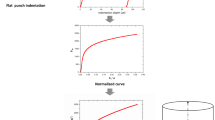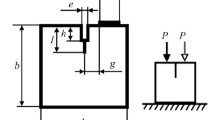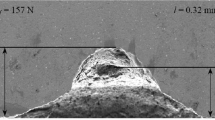Abstract
A testing system is described which measures the fracture stress of square plates. The loading is concentric and the plate is simply supported at the corners. The effective stressed volume can conveniently be changed by varying the diameter of the loading circle. The test is used to measure the fracture characteristics of square alumina plates 103 mm square and 1 mm thick. The displacement of the centre of the plate at fracture is about 3 mm, so the elastic system is geometrically non-linear. A non-linear finite element analysis using the ABAQUS program gave a stress distribution that was found to be in very good agreement with measured stress. The finite element solution was used to calculate stress-volume and stress-area integrals, which are tabulated, and these give the effective volumes and areas, for loading circles of 25 and 7.5 mm diameter. Two batches of plates were fractured, one with a loading circle of 25 mm diameter and the other 7.5 mm. Weibull plots were made assuming zero threshold stress. The first plots used the maximum tensile stress in the plate derived from the measured load using the finite element solution. This stress occurs at the intersection of the plate diagonal with the loading circle. Different values ofm (19.58 and 15.48) were given for the two loading circle diameters. Plots based on the stress determined at the fracture origin gave nearly identical values ofm (13.92 and 13.72). Weibull statistics and the values of the stress-volume or the stress-area integrals were used to predict the ratio of the average fracture stress for the two loading circle diameters. The predictions showed good agreement with the measured values. The stress-area integrals, which are simpler to calculate, gave almost as good predictions as did the stress-volume integrals.
Similar content being viewed by others
References
H. Fessler andD. C. Fricker,J. Strain Anal. 19 (1984) 197.
R. Sedlacek andF. Halven,Rev. Sci. Instrum. 33 (1962) 298.
M. C. Shaw, P. M. Braiden andG. J. deSalvo,Trans. AIME J. Eng. Ind. 97 (1975) 77.
D. A. Gorham andD. G. Rickerby,J. Phys. E. 8 (1975) 794.
D. K. Shetty, A. R. Rosenfield, P. McGuire, G. J. Bansal andW. H. Duckworth,Amer. Ceram. Soc. Bull. 59 (1980) 1193.
P. Stanley, H. Fessler andA. D. Siville,Proc. Brit. Ceram. Soc. 22 (1973) 453.
S. B. Batdorf andJ. G. Cross,Trans. AIME J. Appl. Mech. 41 (1974) 459.
S. B. Batdorf,Int. J. Fract. 13 (1977) 5.
Author information
Authors and Affiliations
Rights and permissions
About this article
Cite this article
Entwistle, K.M. The fracture of concentrically loaded square ceramic plates. J Mater Sci 26, 1078–1086 (1991). https://doi.org/10.1007/BF00576790
Received:
Accepted:
Published:
Issue Date:
DOI: https://doi.org/10.1007/BF00576790




